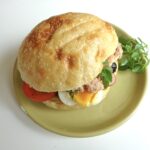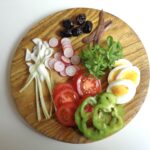 If you’ve ever been to Nice, you will have encountered the pan bagnat, that city’s trademark sandwich: a large roll stuffed with tuna, tomatoes, black olives, hard-boiled egg, anchovies, green pepper, green onion, radishes and basil. It’s like a salade niçoise in a bun. The city is so proud of the sandwich that citizens have formed an association to defend and promote it, with a web page entitled, no less, The Official Site of the Free State of Pan Bagnat.
If you’ve ever been to Nice, you will have encountered the pan bagnat, that city’s trademark sandwich: a large roll stuffed with tuna, tomatoes, black olives, hard-boiled egg, anchovies, green pepper, green onion, radishes and basil. It’s like a salade niçoise in a bun. The city is so proud of the sandwich that citizens have formed an association to defend and promote it, with a web page entitled, no less, The Official Site of the Free State of Pan Bagnat.
Pan bagnat / Pan bagnat sandwich from Nice
On that site they’ve posted what they call the official recipe, which would be just like mine except that it has no green pepper and notes that baby broad beans and/or little artichokes may be added in season. But beware. The site adds a warning: ‘In no case may any other ingredient be added to the authentic Pan Bagnat of Nice under penalty of creating a vulgar vegetable sandwich.’ A vulgar veggie sandwich? Really? How do you say oy vey in French?
So let’s talk about authenticity. According to food historians, the original pan bagnat contained no tuna, which at the time — the 19th century — was considered a food for the rich. The pan bagnat was a poor man’s meal, often made with stale bread (‘pan’ in Provençal) that was bathed (‘bagnat’) with a little water to soften it. These days, the rolls ‘bathe’ in drizzled olive oil and juice from the tomatoes. And while the so-called official recipe may not include green pepper, it is hard to find another recipe without it.
I first encountered the pan bagnat when, as a 19-year-old student, I found myself digging for pre-Neanderthal man in a cave outside Nice for the last three weeks of a summer study program. In the evening after work, the other student diggers and I would walk into town along the corniche, the beautiful coastal road overlooking the Mediterranean. Often as not, we’d pick up a pan bagnat for supper. The sandwich is big enough to be a meal in itself.
Now that spring is finally turning sunny and warm in Paris, it felt like the right time to try to make a pan bagnat at home. Problem No. 1: Where to find the bread? Pan bagnat rolls measure 6-8 inches (15-20 cm) in diameter, i.e. as big as or bigger than a jumbo hamburger bun. They’re crusty outside, tender inside, with an olive oil tang. I had never seen one at a Paris bakery, but a quick online search revealed that at least one Paris baker makes them, and by luck the shop — Tout Autour du Pain — is a short walk from my place.
 Happily I phoned ahead, as the pan bagnat rolls had to be made to order. The next day I collected four beautiful crusty rolls. The rest was easy. I made a sauce of olive oil, garlic and basil, boiled an egg, sliced the veggies, sliced the roll and layered on the ingredients, drizzing with olive oil from time to time. In a very short while the venerable sandwich was ready.
Happily I phoned ahead, as the pan bagnat rolls had to be made to order. The next day I collected four beautiful crusty rolls. The rest was easy. I made a sauce of olive oil, garlic and basil, boiled an egg, sliced the veggies, sliced the roll and layered on the ingredients, drizzing with olive oil from time to time. In a very short while the venerable sandwich was ready.
What to do if there is no such baker in your vicinity? Improvise! You can make your pan bagnat on a Kaiser roll, a pita, a chunk of a crusty French loaf. If you don’t broadcast your deviation from authenticity, the defense committee will never hear about it…
For the record, concerning sandwiches in a bun, the venerable pan bagnat predates the venerable hamburger by at least a century, although the origin of neither is totally clear. When I told an Italian friend I’d be posting the pan bagnat recipe on my French cooking site, she bristled: ‘But that’s an Italian sandwich!’ Since Nice used to be part of Italy, she may have a point. But who cares? The real point is that the sandwich is a treat.
Part of the magic of the pan bagnat is that its taste changes according to the weather. It’s best outdoors on a hot sunny day — at the beach, on a boat, at a picnic. Bring along a bottle of chilled rosé and plenty of napkins to catch the olive oil. The other part of the magic is that, wherever you are when you bite in, the Mediterranean will not be far away.
Happy cooking.




